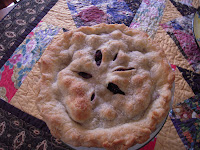What went wrong? I had followed the recipe exactly. That is where I went wrong. My intuition had told me to bake the bottom crust first, because that is what I had done before with fruit pies, to keep it from getting soggy. I also should have added more thickener to the berries. By blindly following a recipe, I had ignored the general cooking wisdom I had gained over the years. Perhaps the berries I used were juicier than those in the video, perhaps my dough was a little wetter than theirs
So how does this relate to statistics? We are designing and teaching an intro stats course that is all about teaching students to really cook (do statistics) rather than just follow recipe. So many introductory courses teach students step-by-step procedures that they follow without thinking or critiquing, like novices. In these courses we may try to provide some theory or rationale for what we do, but we still are teaching recipes, rather than real cooking techniques.
In our CATALST course we aimed to teach students the cooking method of creating models and using them to simulate data, and to use there data to test whether an observed value or difference is surprising, given a particular model. We have spent almost half the course helping students think about models, how to create them using TinkerPlots™ software, how to generate data from them, and how to use the data to evaluate their observed data in order to draw inferences. We hope we are building a foundation of knowledge to enable students to use this approach in their future classes or work---whether they use this particular software tool or not. Rather than walk out of class with a recipe for a t-test that they may or may not ever use again, we hope our students will leave class with some experience doing statistics and the ability to think statistically about real world problems and the nature of statistical inferences.
Even though I tried to reproduce the blackberry pie recipe exactly, I had no way of knowing if my ingredients were exactly the same, my oven the same temperature, my pan the same as theirs, etc. All those things can make a big difference, and a wise cook knows this and can try to compensate and adjust as needed. A novice, follows the instructions blindly, as I did this time. In statistics too, following a procedure blindly, like running a t-test to compare two samples of data, can give different results depending on the characteristics of the samples, where the data came from, etc. We want our students to think critically and statistically when using statistical methods, drawing on their “cooking” knowledge about data, sampling methods, variability, distributions, etc. My pie fiasco served as a reminder of the importance of thinking and questioning rather than blindly following a recipe.
--- This essay was written by Joan Garfield.

This comment has been removed by the author.
ReplyDelete